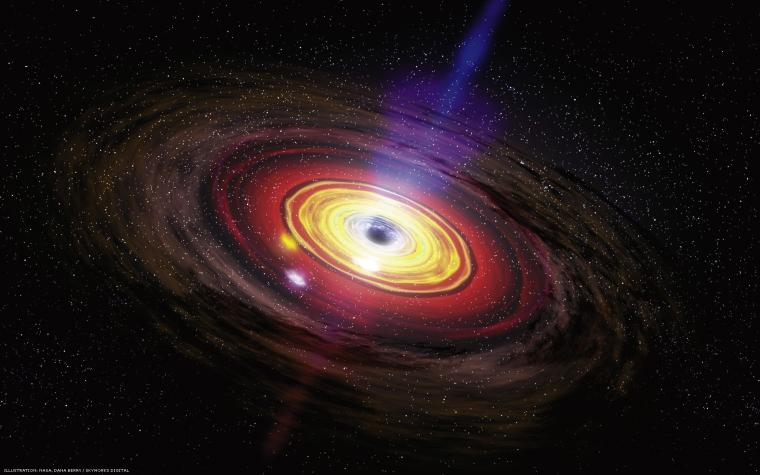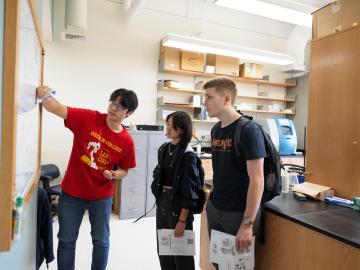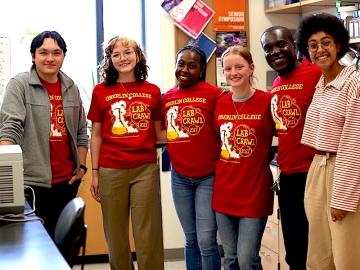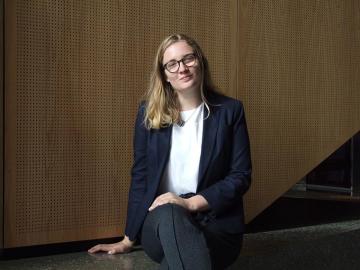Chasing Cosmic Waves
March 27, 2015
Amanda Nagy

Oberlin will play a critical role in a pioneering effort that addresses one of the most compelling challenges in all of physics and astronomy: the detection of low-frequency gravitational waves—elusive ripples in the fabric of space and time.
Dan Stinebring, Francis D. Federighi Professor of Physics and Astronomy, is a senior member of NANOGrav, the group pursuing the research. The National Science Foundation (NSF) has awarded NANOGrav $14.5 million over five years to create and operate a Physics Frontier Center (PFC). The project will focus on the direct detection of low-frequency gravitational waves, which are produced by orbiting supermassive black holes and exotic changes in the early universe.
NANOGrav brings together astronomers and physicists from across the United States and Canada to search for the telltale signature of gravitational waves buried in the steady ticking of distant pulsars. These ultra-stable stars are nature’s most precise celestial clocks.
Theories predict that gravitational waves should come from extremely energetic and large-scale cosmic events, such as orbiting binary black holes found in merging galaxies, phase transitions in the very early universe, or as relics from cosmic inflation, which is the period just after the Big Bang when the universe burst from an incredibly small nugget to become immeasurably big in a tiny fraction of a second.
A key prediction in Einstein’s theory of general relativity is that these events produce waves that distort, or ripple, the actual fabric of the cosmos they pass through. The waves are such low frequency, however, that they would go unnoticed by Earth-based wave detectors.
Stinebring will use his expertise to clean up the signals from the pulsars, the rotating neutron stars that the group uses much like a cosmic GPS. For the last 20 years, Stinebring has specialized in detecting and correcting for the passage of radio waves through the ionized gas. His research has involved more than five dozen Oberlin students since 1990 and has been funded by the NSF since 1993. Now, as a senior member of the NANOGrav PFC, Stinebring’s research will be a core part of the overall effort to detect gravitational waves.
“What Oberlin is doing is critical to the success of the effort,” Stinebring says. “Gravitational waves will delay or advance the ticking of the pulsar clock by only a few billionths of a second, measured over years. In order to be sensitive to such incredibly small signals, we need to carefully remove interstellar delays, which can be hundreds to thousands of times bigger. Fortunately, we and our colleagues around the world have developed analysis tools to do just that.”
Stinebring will involve three to five Oberlin students per year in the project. Through this grant, Oberlin students are afforded the opportunity to participate in the annual international gathering of researchers in this field, which, in 2015, will take place in Australia.
Stinebring and the NANOGrav collaboration conduct observations at the Arecibo Observatory in Puerto Rico and the National Radio Astronomy Observatory’s Green Bank Telescope in West Virginia to study pulsar timing. The success of the NANOGrav research depends on the unmatched capabilities and sensitivity of both telescopes. Once or twice a year, Stinebring brings a team of students to either Arecibo or Green Bank to make observations. In between the on-site visits, they use the telescopes remotely, often on a weekly basis.
NANOGrav was founded in 2007 and, at the time, consisted of 17 members (including Stinebring) in the United States and Canada. It has since grown to 55 scientists and students at 15 different institutions. The NANOGrav PFC will provide funding for 23 senior personnel, six postdoctoral researchers, 10 graduate students, and 25 undergraduate students distributed over 11 institutions.
Xavier Siemens, a physicist at the University of Wisconsin-Milwaukee, is the principal investigator for the project and will serve as director of the center. Maura McLaughlin, an astronomer at West Virginia University, will serve as codirector.
“NANOGrav is now poised to detect low-frequency gravitational waves,” Siemens says. “This center will ensure that researchers have the resources necessary to explore one of the most exciting frontiers in all of physics and astronomy.”
Other institutions funded by the Physics Frontier Center include California Institute of Technology, Cornell University, Franklin and Marshall College, Lafayette College, Montana State University, NASA Goddard Space Flight Center the Universities of Space Research Association, and the National Radio Astronomy Observatory.
Tags:
You may also like…
Friday Afternoon with Lab Crawl
October 30, 2023
Lab Crawl: It’s Not Just for Scientists
October 24, 2023
In the Path of Disaster
August 28, 2023


